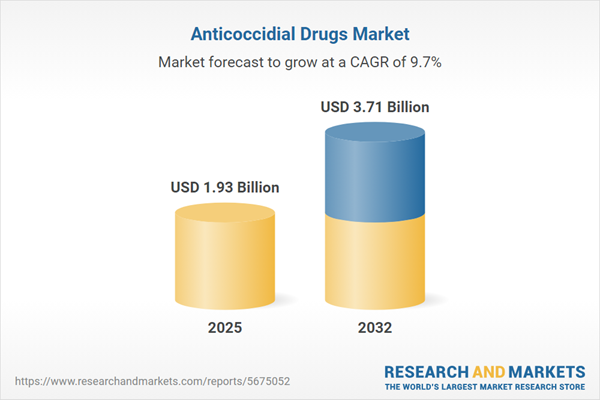Speak directly to the analyst to clarify any post sales queries you may have.
The anticoccidial drugs market is in a period of substantial evolution as producers, regulators, and suppliers reevaluate strategies for managing parasitic diseases in livestock. Shifting compliance requirements, advancing veterinary science, and diverse regional demands are influencing market behavior and shaping the industry’s direction.
Market Snapshot: Anticoccidial Drugs Market Size and Outlook
The global anticoccidial drugs market is achieving consistent growth, with the total market value expected to rise from USD 1.76 billion in 2024 to USD 1.93 billion in 2025, and reach USD 3.71 billion by 2032. This trajectory, with a compound annual growth rate of 9.71%, reflects broad momentum in veterinary pharmaceuticals, new approaches in livestock production systems, and increasing engagement with animal health initiatives. Regulatory changes and consumer preferences continue to drive investment into advanced disease management solutions while redefining supply chain dynamics in both established and emerging geographies.
Scope & Segmentation of the Anticoccidial Drugs Market
- End Use: Solutions targeting cattle, poultry, and swine allow for customized interventions, enabling producers to address diverse disease risks and adapt to operational variations across agricultural segments.
- Distribution Channels: Products are accessed through direct sales, online pharmacies, and specialized retail, which accommodate a variety of procurement strategies. This ensures consistent product availability for veterinary professionals and manufacturers adapting to supply chain complexities.
- Product Types: The market features ionophores like Lasalocid and Monensin, alongside synthetic drugs such as Nitrofurans and Quinolones. These technologies support precise disease control, facilitating compliance with specific regulatory frameworks in global markets.
- Form: Feed additives, liquid solutions, and premixes provide flexibility in delivery, making it feasible to integrate products into various dietary regimens while maintaining adherence to differing regional standards.
- Geography: The landscape spans the Americas, EMEA, and Asia-Pacific. Each region presents unique animal health profiles, regulatory environments, and customer needs, requiring tailored engagement strategies to optimize compliance and lower exposure to risk.
- Companies Analyzed: Companies including Zoetis Inc., Merck & Co., Elanco Animal Health, Boehringer Ingelheim, Bayer AG, Ceva Santé Animale, Kemin Industries, Huvepharma, Novus International, and DCBL Pharmaceuticals shape industry direction and influence best practices through product innovation and operational leadership.
Key Takeaways: Strategic Insights for Senior Decision-Makers
- Flexible distribution and delivery models empower producers to respond quickly as new disease control protocols emerge and production models evolve.
- Innovative dosing and farm management technologies offer enhanced targeting for disease intervention, supporting more effective use of resources and improved health outcomes for livestock.
- Consistently monitoring evolving regulations positions organizations to align compliance procedures swiftly, maintaining market access and minimizing disruption from changing standards.
- Adopting digital traceability tools builds transparency across supply chains, enabling rapid responses to trade fluctuations and ensuring robust response strategies for production demands.
- Commercial strategies that account for local disease risk and producer requirements drive more effective partnerships and long-term customer engagement.
Tariff Impact: Navigating Evolving Cost Structures
Ongoing shifts in United States tariff policies for 2025 have prompted changes in duty rates on essential anticoccidial drug ingredients. These revisions compel businesses to rethink cost management and procurement frameworks. As a result, market leaders are strengthening supply security by evaluating alternative sourcing options and establishing new regional supply hubs to mitigate risk. Proactive supplier vetting and portfolio diversification are enhancing resilience in response to increased volatility in material costs and trade policy.
Methodology & Data Sources
This report is grounded in a rigorous mixed-methods research framework. Peer-reviewed literature, proprietary market datasets, and in-depth interviews with industry experts are synthesized to ensure projections are credible and actionable. Triangulating these data sources delivers a robust foundation for informed decision-making.
Why This Report Matters
- Fosters more precise strategic planning by delivering detailed segmentation and actionable market intelligence tailored to animal health business units.
- Clarifies emerging regulatory, risk, and technology trends—equipping leaders to navigate shifting market pressures and regulatory environments with agility.
- Identifies practical pathways for investment, partnership, and operational improvement, advancing effective disease management practices across the supply chain.
Conclusion
Senior decision-makers gain a clear strategic perspective from this analysis, facilitating alignment of growth, compliance, and operational initiatives as the anticoccidial drugs market moves through a phase of significant change.
Additional Product Information:
- Purchase of this report includes 1 year online access with quarterly updates.
- This report can be updated on request. Please contact our Customer Experience team using the Ask a Question widget on our website.
Table of Contents
3. Executive Summary
4. Market Overview
7. Cumulative Impact of Artificial Intelligence 2025
List of Figures
Samples

LOADING...
Companies Mentioned
The key companies profiled in this Anticoccidial Drugs market report include:- Zoetis Inc.
- Merck & Co., Inc.
- Elanco Animal Health Incorporated
- Boehringer Ingelheim International GmbH
- Bayer Aktiengesellschaft
- Ceva Santé Animale
- Kemin Industries, Inc.
- Huvepharma AD
- Novus International, Inc.
- DCBL Pharmaceuticals Ltd.
Table Information
| Report Attribute | Details |
|---|---|
| No. of Pages | 187 |
| Published | October 2025 |
| Forecast Period | 2025 - 2032 |
| Estimated Market Value ( USD | $ 1.93 Billion |
| Forecasted Market Value ( USD | $ 3.71 Billion |
| Compound Annual Growth Rate | 9.7% |
| Regions Covered | Global |
| No. of Companies Mentioned | 11 |









